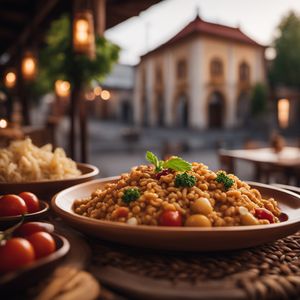
Dish
Pirog
Pirog is a dish that has been enjoyed in Russia for centuries. It is believed to have originated in the rural areas of the country, where it was a staple food for farmers and their families. The dish has since become popular throughout Russia and is now enjoyed by people of all ages and backgrounds. Pirog can be made with a variety of fillings, including beef, pork, chicken, mushrooms, and potatoes. The crust is typically made from flour, water, and butter, and is rolled out to form a thin layer that is then filled with the desired ingredients. The pie is then baked in the oven until the crust is golden brown and the filling is cooked through. Pirog is a delicious and satisfying dish that is perfect for any occasion.
Origins and history
Pirog is a traditional Russian dish that has been enjoyed for centuries. It is believed to have originated in the rural areas of the country, where it was a staple food for farmers and their families. The dish has since become popular throughout Russia and is now enjoyed by people of all ages and backgrounds. Pirog can be made with a variety of fillings, including beef, pork, chicken, mushrooms, and potatoes. The crust is typically made from flour, water, and butter, and is rolled out to form a thin layer that is then filled with the desired ingredients. The pie is then baked in the oven until the crust is golden brown and the filling is cooked through.
Dietary considerations
Pirog can be made to accommodate a variety of dietary needs. For those who are vegetarian, the pie can be filled with a variety of vegetables, such as mushrooms, onions, and peppers. For those who are gluten-free, the crust can be made with alternative flours, such as almond or coconut flour. Pirog can also be made with low-fat ingredients, such as lean meats and reduced-fat cheese. It is important to note that Pirog may contain allergens such as dairy, wheat, and eggs.
Variations
Pirog can be made with a variety of fillings, including beef, pork, chicken, mushrooms, and potatoes. The crust can also be made with alternative flours, such as almond or coconut flour, to accommodate those who are gluten-free. Some popular variations of Pirog include adding hard-boiled eggs, sauerkraut, or rice to the filling. Pirog can be served with a variety of side dishes, such as a simple green salad or roasted vegetables. It pairs well with a variety of drinks, including beer, wine, and vodka. Pirog can be garnished with fresh herbs, such as parsley or dill, to add a pop of color and flavor to the dish.
Presentation and garnishing
Pirog can be presented on a large platter and garnished with fresh herbs, such as parsley or dill. Slices of lemon or lime can also be added to the platter for a pop of color. To add a decorative touch, use a cookie cutter to cut out shapes from the leftover dough and place them on top of the Pirog before baking.
Tips & Tricks
To prevent the filling from spilling out of the Pirog, make sure to seal the edges of the crust tightly. If the crust is too dry, try brushing it with a beaten egg before filling it. This will help to create a seal and prevent the filling from leaking out. To add extra flavor to the crust, try adding herbs or spices, such as garlic powder or dried oregano, to the dough before rolling it out.
Side-dishes
Pirog can be served with a variety of side dishes, such as a simple green salad or roasted vegetables. Mashed potatoes or a creamy mushroom sauce can also be served as a side dish. When making Pirog, it is important to roll out the dough evenly to ensure that the crust cooks evenly. It is also important to let the pie cool for a few minutes before slicing it, as this will help the filling set and prevent it from spilling out. To add extra flavor to the filling, try adding herbs and spices, such as thyme, rosemary, or paprika.
Drink pairings
Pirog pairs well with a variety of drinks, including beer, wine, and vodka. For a non-alcoholic option, try serving Pirog with a glass of cold milk or a fruit juice.
Delicious Pirog recipes
More dishes from this category... Browse all »

Adjarian khachapuri
Georgian cuisine

Alevropita
Greek cuisine

Bacon and Egg Pie
British cuisine

Beef and Guinness Pie
Irish cuisine

Belokranjska povitica
Slovenian cuisine

Benkovački prisnac
Croatian cuisine

Bureek tajin
Algerian cuisine

Bölletünne
German cuisine
More cuisines from this region...

Bashkir cuisine
Hearty, Savory, Flavorful, Spicy, Aromatic

Chechen cuisine
Bold, Spicy, Flavorful, Aromatic, Savory

Chukchi cuisine
Simple, Fresh, Flavorful, Unique, Rustic

Mordovian cuisine
Hearty, Savory, Rich, Creamy, Earthy

Tatar cuisine
Bold, Spicy, Flavorful, Aromatic, Savory

Yamal cuisine
Savory, Smoky, Earthy, Tart

